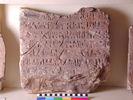Abydos
(26°11' N 31°53'E)
Abydos was an important centre already in the Naqada and Early
Dynastic Periods. Extensive cemeteries dating to this time have been excavated
across the site, including the tombs of First and Second Dynasty kings. In the
Old Kingdom (about 2686-2181 BC) the principal deity of Abydos was called Khentyamentyu
'foremost of the Westerners'; by the First Intermediate Period this god had
been identified with Osiris. With the growing importance of Osiris at the end
of the Old Kingdom Abydos became a religious centre of national importance.
In the Middle Kingdom (about 2025-1700 BC) one of the First Dynasty royal tombs
was considered the burial place of Osiris, and there were festival processions
each year from the temple in the town to the First Dynasty royal cemetery in
the desert. It became desirable to be buried close to the god or at least be
present in the temple or on the processional way: here many officials had chapels
set up with one or more stelae. From the New Kingdom (about 1550-1069 BC) down
to the Ptolemaic Period (305-30 BC), Abydos remained a burial place of national
importance. During the Ptolemaic Period, it seems to have been eclipsed by other
regional centres, such as Akhmim, but the cult of Osiris was still central to
Egyptian belief, and stelae for chapels were still being set up in Abydos in
the early Roman Period.
Copyright © 2000 University College London. All rights
reserved.



